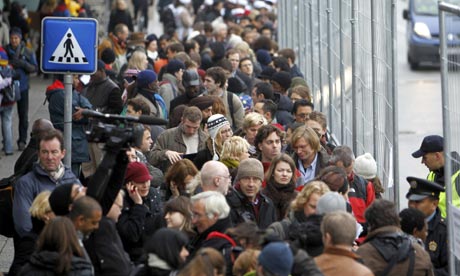 La mayoría culpa a los automóviles y las fábricas por el cambio climático y los efectos devastadores que están teniendo en los patrones del clima global. Y esta semana en la Conferencia sobre el Cambio Climático de las Naciones Unidas en Cancún, también conocida como la UNFCCC COP16, los gobiernos internacionales y las delegaciones pasarán mucho tiempo en negociaciones, y discutiendo sobre culpas y soluciones.
La mayoría culpa a los automóviles y las fábricas por el cambio climático y los efectos devastadores que están teniendo en los patrones del clima global. Y esta semana en la Conferencia sobre el Cambio Climático de las Naciones Unidas en Cancún, también conocida como la UNFCCC COP16, los gobiernos internacionales y las delegaciones pasarán mucho tiempo en negociaciones, y discutiendo sobre culpas y soluciones.
Pero es probable que lo que está en nuestros platos es igual de perjudicial para el clima. La producción de alimentos en el mundo genera entre 13 y 30 por ciento de la emisión de gases de efecto invernadero que están causando el calentamiento global. Del campo, a la mesa, y al cesto de la basura, los alimentos que producimos, comemos y desechamos pueden tener un gran impacto sobre el medio ambiente, tanto como los vehículos que conducimos y los derrames de petróleo que producimos, y es crucial que lo que esté en nuestro plato también deba estar en la agenda de la UNFCCC.
Mediante la exploración de formas alternativas de producir, preparar y desechar los alimentos, podemos ayudar tanto a los agricultores de todo el mundo a poner fin al hambre y revertir el cambio climático. Encerrado en el suelo y en los árboles y plantas hay tres veces más carbono del que puede aguantar la atmósfera de la Tierra. Muchas prácticas agrícolas de hoy reducen la capacidad del suelo para encerrar el carbono, lo que libera una mayor cantidad de este gas de efecto invernadero a la atmósfera. Pero hay métodos agrícolas alternativos que mantienen el carbono enterrado, como restaurar los procesos naturales que garantizan que los niveles atmosféricos de carbono sean bajos.
En el Sahel, la extrema sequía en los últimos 40 años ha disminuido la producción de alimentos y desplazado a gran parte de la población. Pero los pequeños agricultores están cambiando la situación, mejorando sus medios de vida y su dieta y contribuyendo a mitigar el cambio climático mediante el cultivo de árboles autoctónos.
[Read the rest of Danielle Nierenberg’s and my op-ed in E Nuevo Herald here]


 Es hatte alles so schön begonnen, im Herbst 2008. Die Hoffnung auf Veränderung, die Barack Obama damals bei den amerikanischen Wählern geweckt hatte, sie wurde von vielen Menschen weltweit geteilt, und gerade auch von jenen, die einen Wandel der US-Umweltpolitik herbeisehnten. Immerhin hatte Obama die Erderwärmung und die Energiepolitik zu wichtigen Themen seiner Wahlkampagne gemacht. Stets aufs Neue tat er seine Überzeugung kund, dass diejenige Nation, die im Wettbewerb um neue Energietechnologien vorn sein werde, auch die Weltwirtschaft in diesem Jahrhundert anführen würde. Einmal im Weißen Haus, erklärte der neu gewählte Präsident, dass nur wenige Herausforderungen für Amerika und die Welt dringender seien als der
Es hatte alles so schön begonnen, im Herbst 2008. Die Hoffnung auf Veränderung, die Barack Obama damals bei den amerikanischen Wählern geweckt hatte, sie wurde von vielen Menschen weltweit geteilt, und gerade auch von jenen, die einen Wandel der US-Umweltpolitik herbeisehnten. Immerhin hatte Obama die Erderwärmung und die Energiepolitik zu wichtigen Themen seiner Wahlkampagne gemacht. Stets aufs Neue tat er seine Überzeugung kund, dass diejenige Nation, die im Wettbewerb um neue Energietechnologien vorn sein werde, auch die Weltwirtschaft in diesem Jahrhundert anführen würde. Einmal im Weißen Haus, erklärte der neu gewählte Präsident, dass nur wenige Herausforderungen für Amerika und die Welt dringender seien als der 

